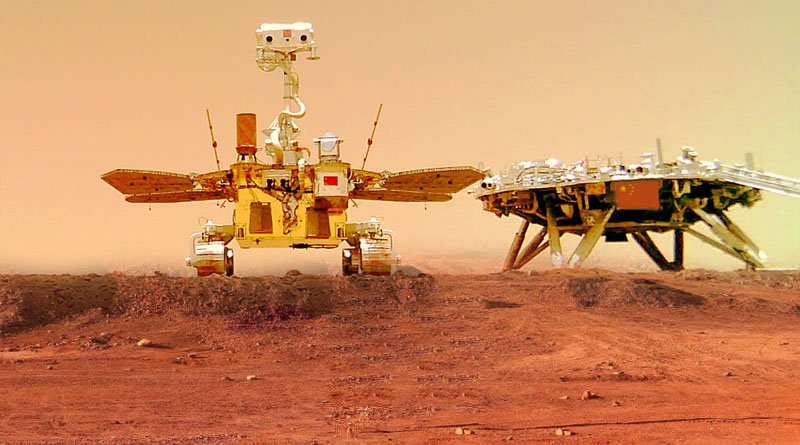The Mars Sun Transit is a phenomenon in which Earth and Mars move to opposite sides of the sun, and the three are almost in a straight line.

In an “almost-out-of-service” period in 2021, China’s Tianwen-1 orbiter, along with Mars Express of the European Space Agency, helped solar scientists know more about what happens near the sun.
During the late September to mid-October stretch in 2021, China’s Mars Express of the European Space Agency experienced its first sun transit, when its communication with Earth was significantly disturbed by solar radiation.
The Mars Sun Transit is a phenomenon in which Earth and Mars move to opposite sides of the sun, and the three are almost in a straight line. During the transit, Tianwen-1 and Mars Express sent out frequent signals, allowing radio telescopes on Earth to examine how those signals were affected.
A paper published recently in Astrophysical Journal Letters revealed that on Oct. 9, 2021 — when the red planet’s projection point near the sun was 2.6 times solar radius away from the sun’s center — a violent solar burst event called a coronal mass ejection (CME) caused noticeable disturbances for a period of 10 minutes.
Also, coronal waves were detected near the projection point, a phenomenon reflecting how magnetic fields constrain solar winds, according to the study led by scientists from the Chinese academy of Sciences.
During the blackouts, China’s Mars probe continued its observation together with the European Mars Express orbiter. By transmitting radio signals from the two orbiters periodically to the Earth, scientists from multiple countries used more than a dozen radio telescopes to observe the signals under the influence of the Sun, obtaining a large amount of data.
More than six research institutes from China, Australia and Europe co-published the research results on The Astrophysical Journal Letters, a peer-reviewed scientific journal of astrophysics and astronomy.
According to one of the authors – Ma Maoli, a research fellow at the Shanghai Astronomical Observatory under the Chinese Academy of Sciences – when the Mars projection point was 2.6 Rs from the heliocenter on October 9, 2021, six observatories received radio signals from Tianwen-1 and Mars Express, with the strongest ±20 Hz turbulences occurring for up to 10 minutes.
By observing these turbulences, researchers have found that when the radio signals traveled through the near-Sun region, the total electron content changed by thousands of TECU, caused by coronal mass ejection (CME) phenomenon, a significant release of plasma and accompanying magnetic field from the Sun’s corona into the heliosphere.
Experts said that the success of this joint study can be attributed to the high sensitivity of the radio remote-sensing observation of Tianwen-1 and the Mars Express, as well as high temporal and spatial resolution thanks to the collaboration of multiple stations in China and overseas.
The new study comes amid Western hype over China’s Mars rover Zhurong, which went into hibernation in May and was expected to rewake last month. Some in the West said it is unlikely to resume operations, in an attempt to undermine China’s space capabilities.
Zhurong was put into sleep mode in May last year to wait out the red planet’s extremely cold winter and fierce sandstorms, but it has yet to re-connect with the Earth, after the season has passed.
Huang Zhicheng, a Chinese expert in aerospace science and technology, told the Global Times on Monday that hyping Zhurong’s delayed wake-up to try undermining China’s space progress is unjustified.
Being the country’s first interplanetary mission, the rover fulfilled all its preset goals in August 2022 – with a expected lifespan of about 90 Martian days, or roughly 92 days on Earth – and it then survived the solar outage, providing a large amount of valuable data for world scientists to study.
Although it is spring time on Mars, waking up the rover needs to meet certain requirements such as the proper and warmer temperature, and whether the region in question could provide enough solar energy for such an operation, Yu Tianyi, deputy director of the scientific research planning office with the Beijing Aerospace Flight Control Center, told the Global Times on Monday.
“We have been closely following such conditions and admittedly there is uncertainty about the rover’s solar panel – to what extent is it affected by sandstorms during the Martian winter? The panels’ power generating capability could have been affected,” according to Yu.
“We have to consider all those factors and uncertainties and we will wake up the rover at a proper time when all the conditions are met,” he noted.
China’s Tianwen-1 orbiter is a robotic spacecraft that was launched on July 23, 2020, on a mission to study the planet Mars. The spacecraft is made up of an orbiter, a lander, and a rover and is expected to complete a series of scientific observations of the Martian surface and atmosphere.
The orbiter’s main task is to map the Martian surface and study the planet’s geology, soil, and water ice distribution. It will also study the planet’s atmosphere and climate and search for signs of past or present life.
This mission is considered a major milestone for China’s space program, and it is the first independent Mars exploration mission by China. The data collected by Tianwen-1 will be shared with the international scientific community and will enhance our knowledge of the red planet.
Originally published at Urdu Point
